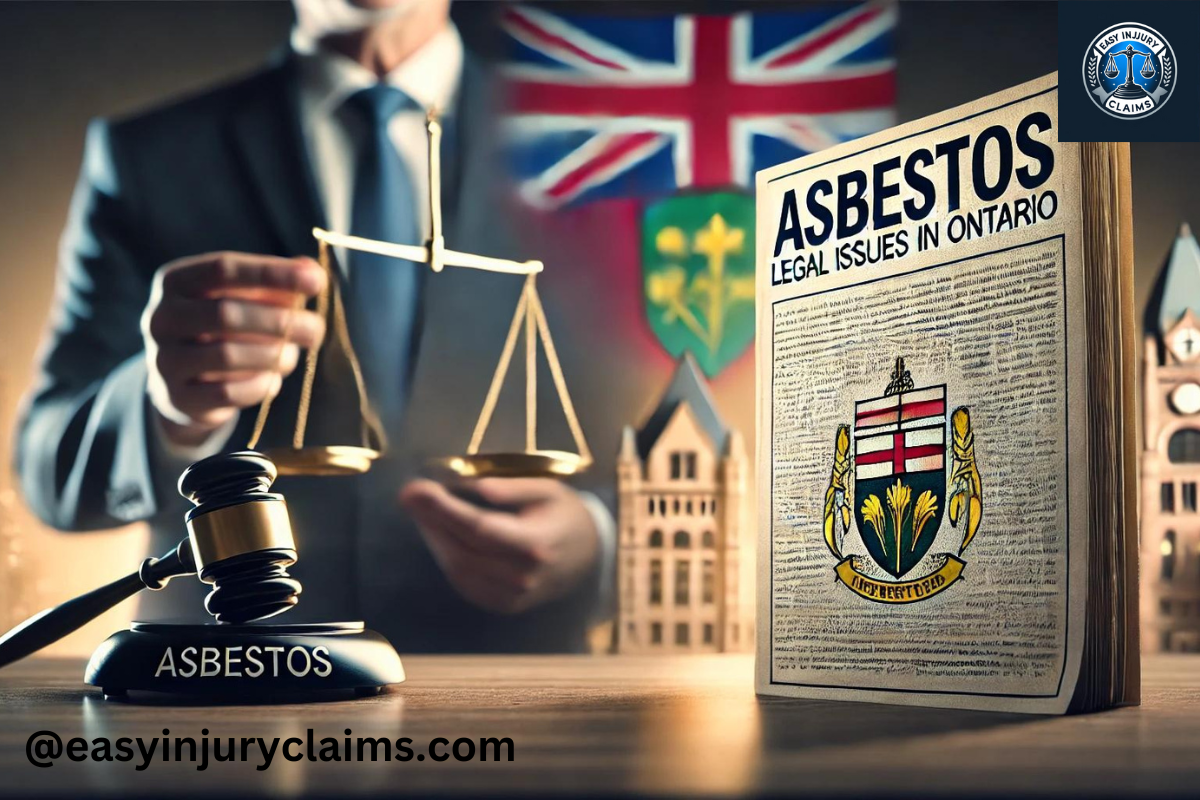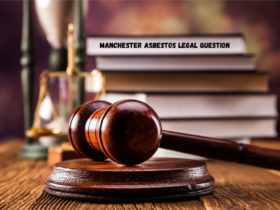Introduction to Asbestos in Ontario
Asbestos was a common material used in Ontario because it was strong and could resist fire. Many buildings in Ontario built before the 1980s still have asbestos in them. At that time, people didn’t know how dangerous asbestos could be. When asbestos breaks, tiny fibers can float in the air. If someone breathes in these fibers, it can cause serious health problems, like lung disease and cancer.
The legal question in Ontario is about how to deal with asbestos now that we know it is harmful. Ontario has strict laws to manage and remove asbestos safely. These laws are there to protect people from the risks of asbestos exposure.
Identifying Asbestos in Buildings
Asbestos is usually found in older buildings in Ontario, especially those built before the 1980s. These buildings may have asbestos in insulation, flooring, roofing, or other construction materials. It’s hard to see asbestos without special training, so a regular person might not even know it’s there.
This is why professional inspections are very important. Experts can safely check for asbestos and make sure it is handled correctly. In Ontario, a designated substance survey (DSS) is often required for buildings that are being renovated or demolished. This survey is done by professionals to find out if there is asbestos or other dangerous materials in the building. The results of the DSS help make sure everyone stays safe by following the right steps to manage or remove asbestos.
Ontario’s Legal Framework for Asbestos Management
In Ontario, the management of asbestos is strictly regulated to protect public health. Two key regulations guide how asbestos is handled in various settings:
Ontario Regulation 278/05: This regulation specifically addresses how asbestos should be identified, managed, and removed. It requires that asbestos be assessed by a qualified professional before any renovation or demolition work is done. The regulation also sets out detailed procedures for the safe removal of asbestos to prevent exposure to harmful fibers.
Occupational Health and Safety Act (OHSA): Under the OHSA, employers have a legal duty to protect workers from hazards, including asbestos exposure. This means they must ensure that any asbestos found in the workplace is properly managed. Employers must provide proper training and equipment to workers who may come into contact with asbestos. They must also ensure that asbestos is removed or contained following the safety standards outlined in the OHSA.
Springfield Asbestos Legal Questions: Understanding Your Rights and Options
Legal Responsibilities for Property Owners
In Ontario, property owners have specific legal duties when it comes to managing asbestos. If asbestos is found in a building, the owner must take steps to ensure it is handled safely to protect the health of anyone using the building.
Managing Asbestos: Property owners must have the building inspected for asbestos by a qualified professional, especially before any renovations or demolitions. If asbestos is present, the owner must ensure that it is either safely contained or properly removed according to Ontario Regulation 278/05. The work must be done by licensed professionals to prevent exposure to harmful asbestos fibers.
Disclosing Asbestos: When selling or leasing a property, owners are legally required to disclose the presence of asbestos to potential buyers or tenants. This disclosure is crucial because it informs the new occupants of the risks and the need for proper management.
Legal Implications of Non-Compliance: Failing to manage or disclose asbestos can lead to serious legal consequences. Property owners can be held liable for any health issues that arise from exposure to undisclosed asbestos. They may face lawsuits, fines, or penalties if it is found that they did not follow the legal requirements for asbestos management.
Asbestos Removal and Disposal
In Ontario, the removal and disposal of asbestos are strictly governed by regulations to protect public health and safety. These regulations are designed to ensure that asbestos is handled with care to prevent exposure to its harmful fibers.
Regulations Governing Asbestos Removal: Ontario Regulation 278/05 sets out the specific procedures for asbestos removal. This regulation requires that only certified professionals carry out the removal of asbestos. These professionals must follow detailed protocols to contain and remove asbestos safely, minimizing the risk of fiber release into the air.
Importance of Using Certified Professionals: Certified professionals have the training and expertise needed to handle asbestos safely. They use specialized equipment and protective gear to prevent exposure during the removal process. Using uncertified workers or attempting to remove asbestos without proper training can lead to dangerous exposure, legal consequences, and potential health risks.
Procedures for Safe Disposal: Once asbestos is removed, it must be disposed of in accordance with Ontario’s environmental regulations. Asbestos waste must be sealed in leak-proof containers, labeled, and transported to designated disposal sites. The disposal process must follow a strict chain of custody to ensure that the asbestos is not released into the environment during transportation or disposal. Only certain authorized sites in Ontario are permitted to accept asbestos waste, where it is safely buried to prevent contamination.
Understanding Plymouth Mesothelioma Legal Questions: A Guide for Victims
Workers’ Rights and Compensation
In Ontario, workers who are exposed to asbestos have specific rights to protect their health and seek compensation if they become ill due to exposure.
Workers’ Rights: Under the Occupational Health and Safety Act (OHSA), workers have the right to a safe workplace, free from hazardous exposure to substances like asbestos. Employers must provide proper training, protective equipment, and ensure that all safety regulations are followed when dealing with asbestos. Workers also have the right to be informed if asbestos is present in their workplace and what measures are in place to protect them.
Role of the Workplace Safety and Insurance Board (WSIB): If a worker is exposed to asbestos and develops a related illness, such as asbestosis or mesothelioma, they may be eligible for compensation through the Workplace Safety and Insurance Board (WSIB). The WSIB provides benefits for lost wages, medical expenses, and other related costs. Workers must report their condition to the WSIB as soon as possible to begin the claims process.
Pursuing Personal Injury Claims: In addition to WSIB benefits, workers may also have the option to pursue a personal injury claim if they believe their illness was caused by negligence on the part of their employer or another party. This could involve proving that the employer failed to follow safety regulations or did not adequately protect workers from asbestos exposure. Successful personal injury claims can result in compensation for pain and suffering, lost wages, and medical costs beyond what is covered by the WSIB.
Filing Asbestos-Related Lawsuits in Ontario
In Ontario, filing a lawsuit related to asbestos exposure involves understanding several key legal aspects, including the statute of limitations, the types of compensation available, and the challenges in proving such claims.
Statute of Limitations: The statute of limitations for filing an asbestos-related lawsuit in Ontario is generally two years. This period starts from the date when the individual is diagnosed with an asbestos-related disease, such as mesothelioma or asbestosis, or when they reasonably should have known about their illness. It’s crucial to file the claim within this timeframe to avoid losing the right to seek compensation.
Types of Compensation Available:
Individuals who successfully file an asbestos-related lawsuit may be eligible for various forms of compensation. This can include:
-
- Medical Expenses: Costs related to treatment, hospitalization, and ongoing medical care.
- Lost Wages: Compensation for income lost due to illness or inability to work.
- Pain and Suffering: Damages for physical and emotional distress caused by the illness.
- Loss of Enjoyment of Life: Compensation for the reduced quality of life due to the illness.
- Wrongful Death: Family members can file a claim on behalf of a deceased loved one who died due to asbestos exposure, seeking compensation for their loss.
Challenges in Proving Asbestos-Related Claims:
Proving an asbestos-related claim can be difficult due to several factors:
-
- Latency Period: Asbestos-related diseases often take decades to develop, making it challenging to trace back the exposure to a specific time or place.
- Identifying Responsible Parties: Over time, companies responsible for asbestos exposure may have gone out of business, merged, or changed names, complicating the process of holding them accountable.
- Gathering Evidence: It can be tough to gather sufficient evidence to directly link the illness to asbestos exposure, especially when exposure occurred many years ago. This often requires the testimony of expert witnesses, such as medical professionals or industrial hygienists.
Challenges and Future Legal Considerations
Asbestos litigation in Ontario faces ongoing challenges that make it complex and difficult for victims to seek justice. One of the main challenges is identifying responsible parties. Many companies that produced or used asbestos have gone out of business, changed names, or merged with other companies. This makes it difficult for plaintiffs to pinpoint who is legally responsible for their asbestos-related illnesses. Without a clear responsible party, it becomes challenging to file a successful lawsuit. Another significant challenge is gathering evidence. Asbestos-related diseases often take decades to develop, meaning that exposure might have occurred many years ago. Over time, records may be lost, and witnesses may be hard to find or no longer available. Proving a direct link between the exposure and the illness requires detailed documentation and expert testimony, which can be hard to secure after so many years.
Looking ahead, there are potential changes in asbestos-related laws and regulations in Ontario. As awareness of the dangers of asbestos continues to grow, there may be stricter regulations introduced to ensure better protection for workers and the public. These could include tighter controls on asbestos removal, more stringent disclosure requirements for property transactions, and increased penalties for non-compliance. Legal reforms might also focus on making it easier for victims to file claims by extending the statute of limitations or simplifying the process of identifying responsible parties. As the legal landscape evolves, it will be crucial for individuals and businesses in Ontario to stay informed about these changes to ensure compliance and protect their rights.
Conclusion
Legal compliance in asbestos management is crucial for protecting public health and avoiding severe consequences. In Ontario, strict regulations govern the identification, removal, and disposal of asbestos to ensure safety in workplaces and properties. Failing to comply with these laws can result in significant fines, lawsuits, and health risks for those exposed to asbestos.
For individuals affected by asbestos exposure, seeking professional legal advice is essential. An experienced lawyer can help navigate the complex legal landscape, identify responsible parties, and pursue rightful compensation. Understanding and adhering to asbestos regulations not only protects you legally but also ensures the safety and well-being of everyone involved.
Dive into the world of Legal Service with Easy Injury Claims. Visit our website to uncover endless inspiration!












Got a Questions?
Find us on Socials or Contact us and we’ll get back to you as soon as possible.